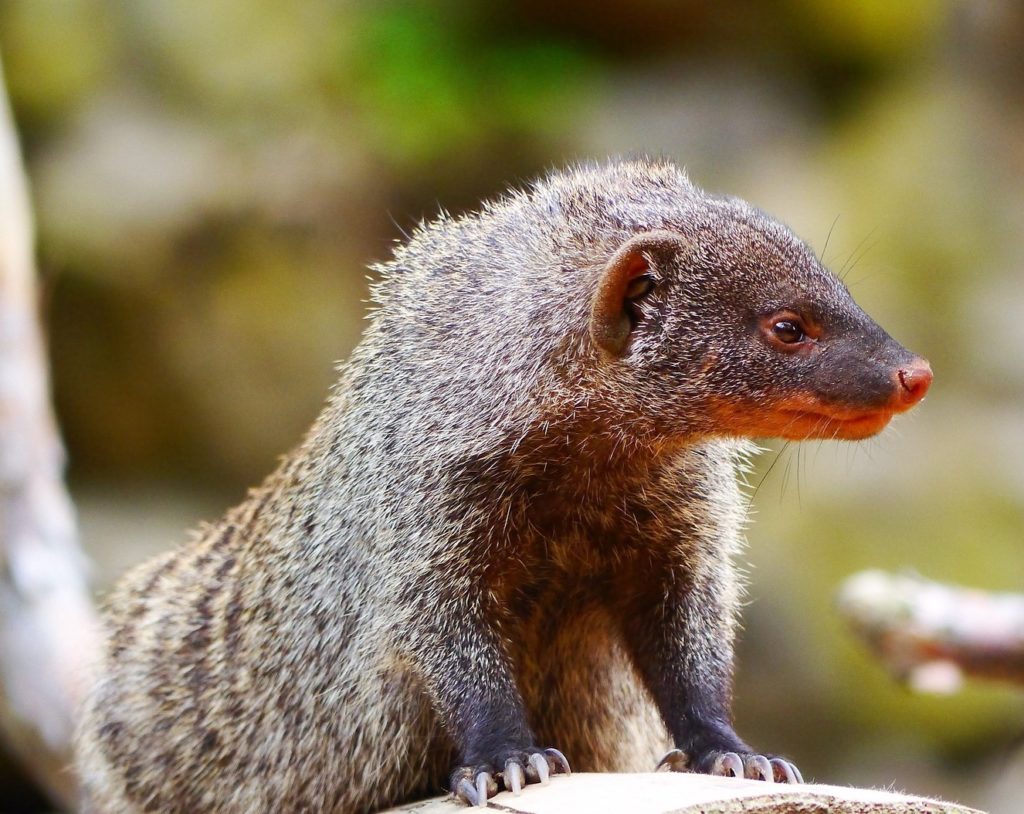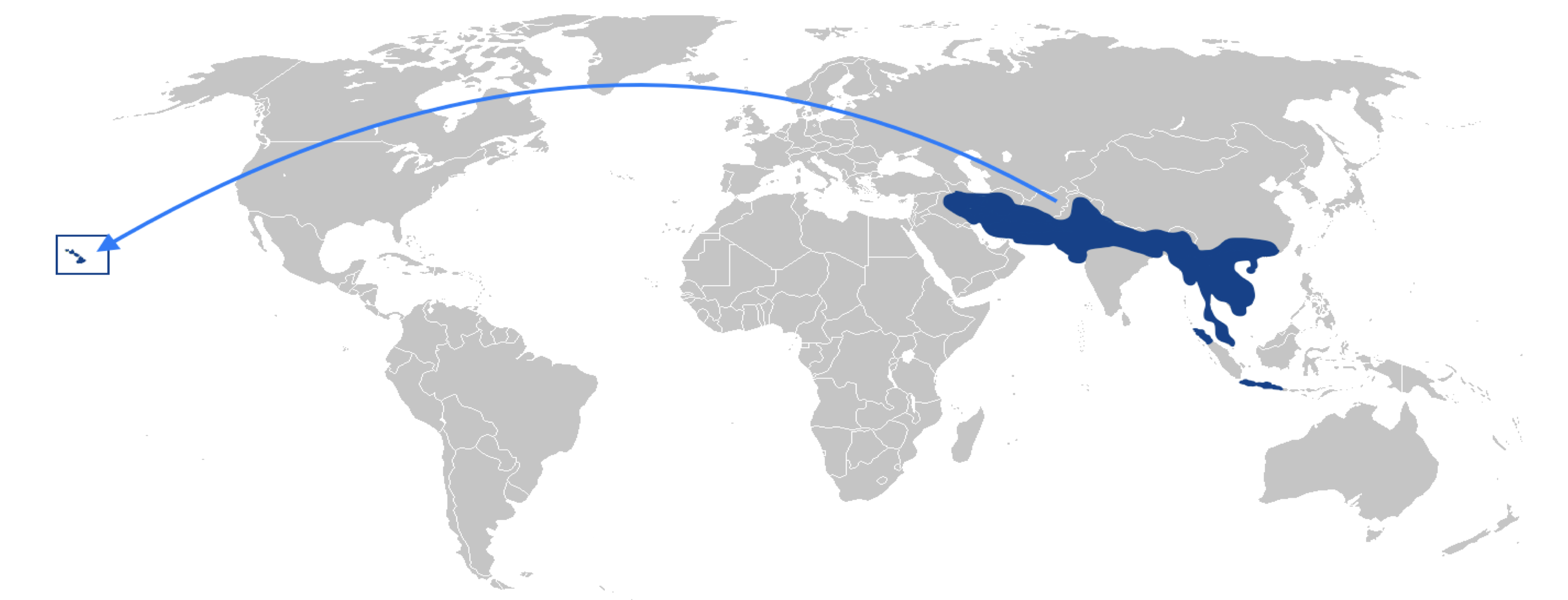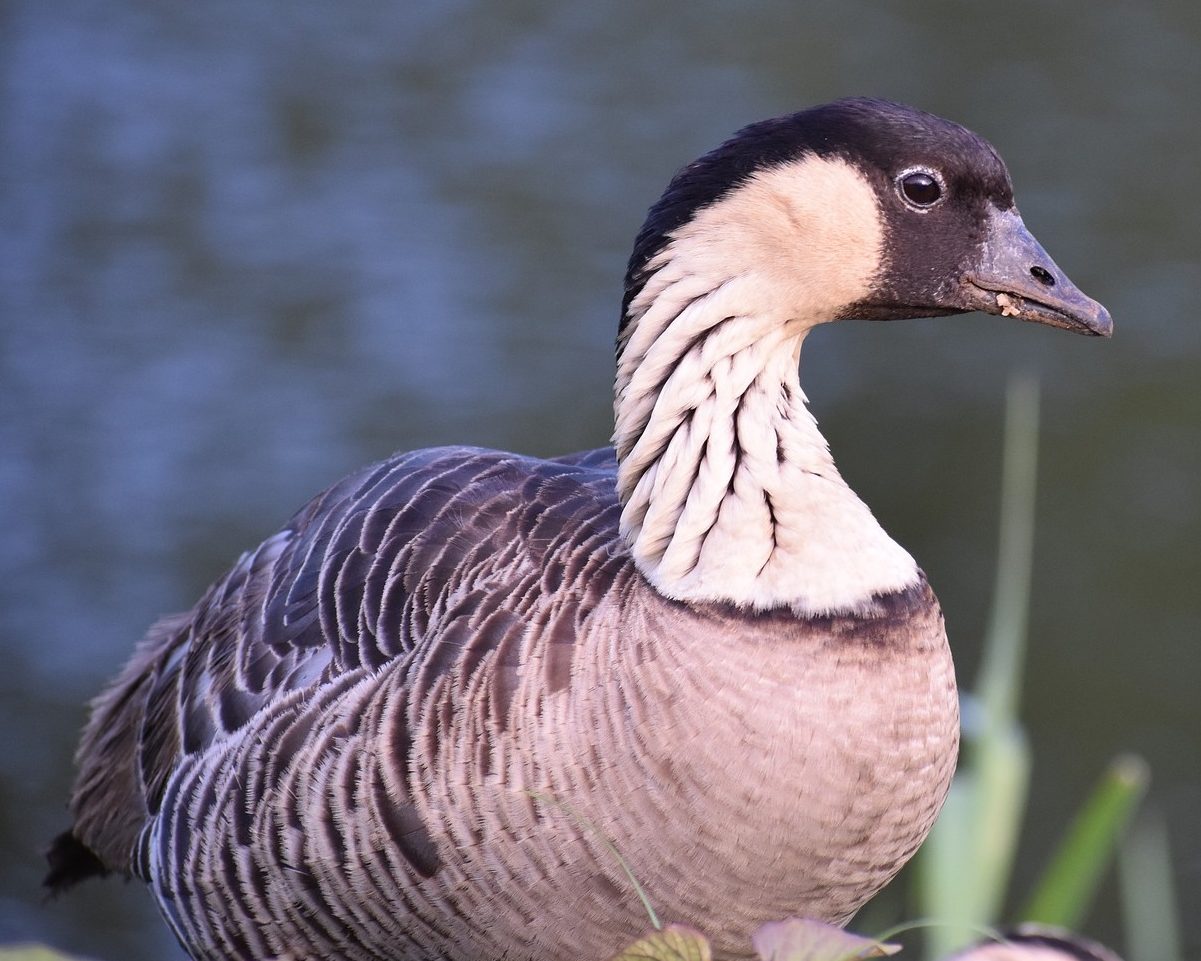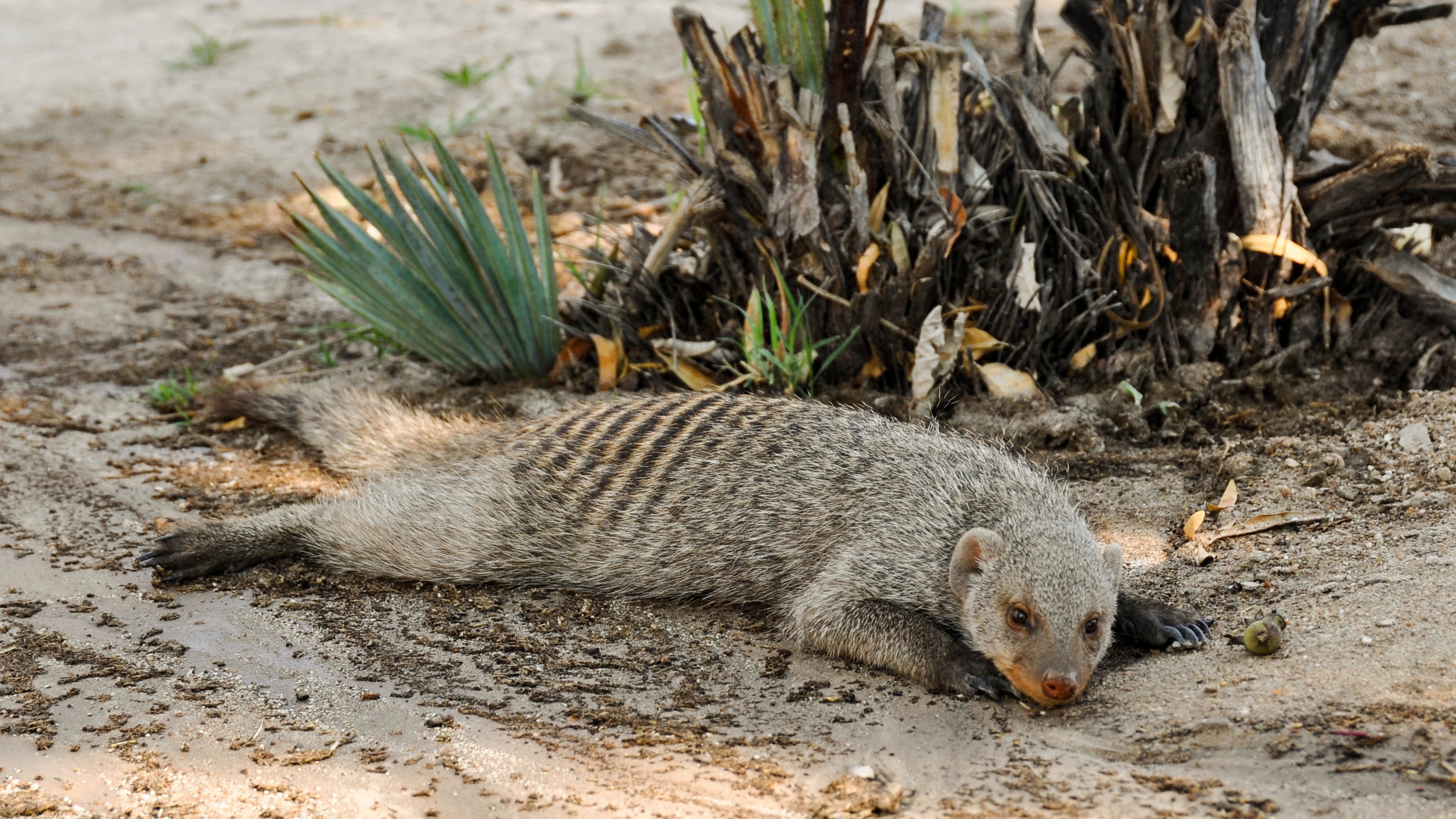Invasive Species
1.5 Non-Native Mongoose (Herpestes javanicus): A Threat to Hawaiian Islands
Katie E. Fineran
In 1883, the Hawaiian sugar cane industry imported the mongoose to control rats. Today it endangers many of Hawaii’s endemic species, including the nene. What role does the mongoose play in the Hawaiian environment and how can the mongoose be controlled?

The Small Indian Mongoose (Herpestes javanicus) is a slender weasel-like creature with brown fur, short legs, and a long tail which accounts for about 40% of its overall length. The mongoose is completely diurnal and dens in shallow burrows.3 They move via a brisk gallop or a low slink and are not easily observed by scientists as they make use of dense cover.1
Although its native range stretches across Southeast Asia, the mongoose has been introduced by humans to many other regions of the world including at least 45 islands. All of these introductions were intentional as a method to control rats and snakes.7 The mongoose was first introduced to the Hawaiian Islands in 1883 (Figure 2).1,2,3,5,7,8 The sugarcane industry imported the mongoose to the islands to control rat populations that were damaging yields.2 Improved rat-poisoning techniques eventually replaced the need for the mongoose, but mongoose populations were well-established by that time. Although the mongoose does eat small mammals and rodents, like rats and mice, it is omnivorous and eats a wide variety of organisms. The mongoose diet varies widely depending on where it is introduced. In Hawaii, the mongoose diet includes birds, reptiles, amphibians, plants, insects, and crustaceans. The mongoose is an aggressive predator and has been observed preying on fawns of white-tailed deer.3 Its efficient hunting tactics primarily consist of a bite to the back of the head that crushes the victim’s skull.1,3,7 Mongoose have been observed working together to hunt, such as a pair on Oahu that shared tasks: as one overturned rocks, the other attacked emerging crabs.1 Mongooses have exceptional vision for a small mammal and they also have the ability to perceive colors.3

Once introduced, the mongoose quickly presented new problems for the islands. The species spread rapidly and preyed on the native wildlife. In Hawaii, the mongoose breeding season runs from February through August and gestation takes 49 days, which allow mothers to raise 2 or 3 litters each year.1,3 Pups are born in litters of 1 to 5 and begin hunting with their mothers at 6 weeks.1,3,7 They reach sexual maturity at 4 months, giving the mongoose a relatively rapid cycle of reproduction.3 Mongoose have no natural predators and very few parasites or diseases on the Hawaiian Islands to control their population. A non-native, invasive species and effective predator like the mongoose poses a significant threat to Hawaii’s unique ecosystem.2,4 Of all the species on the U.S. endangered species list, 25% are endemic to Hawaii.4 Hawaiian biota is extremely vulnerable to introduced predator species after having evolved over thousands of years without them.8 Sea turtles, including the loggerhead, hawksbill, leatherback, and green sea turtles, all suffer from mongoose predation of their eggs.2,3,5 Eight of Hawaii’s federally endangered birds suffer heavily from nest-predation by the mongoose, including the nēnē (Branta sandvicensis) (Figure 3).2,8,10 Ground-nesting birds are at particular risk. On other islands, at least two ground-nesting bird species have become extinct due to mongoose predation, including the barred-wing rail in Fiji and the Jamaica petrel.3 Within the Hawaiian Island chain, the mongoose has stable populations on the islands of Hawaii, Oahu, Molokai, Maui, and most recently, Kauai.5 The mongoose continues to negatively affect the native biota and presents a significant challenge for conservationists.6
One of Hawaii’s most well-known and beloved endangered species is the Hawaiian goose, or nēnē (pronounced nay-nay). The nēnē was placed on the very first endangered species list when it was created under the Endangered Species Preservation Act of 1966.9 Many studies have been conducted to investigate the various causes of nēnē mortality. Leading mortality factors include emaciation, trauma from vehicle-strikes, predation, and disease.10 Much conservation work has been done to restore the nēnē population in Hawaii.9 Captive-breeding efforts have been extensively used to restore the population, but more work remains, as nest predation hinders successful reproduction in the wild.9,10 Average clutch-size is 3 eggs with a lengthy incubation period of thirty days.9 Once hatched, chicks remain flightless for 10-14 weeks making them vulnerable to mongoose predation for an extensive period.9 The largest population of nēnēs was established on Kauai, predictably due to the absence of mongoose there until recently.10 Discovery of a new mongoose population becoming established on Kauai has many nēnē conservationists concerned. The mongoose makes it difficult for conservationists to reestablish nēnē populations, and that of many other ground-nesting birds to their historical range.

Researchers are trying to determine the effectiveness of various methods for eliminating the mongoose. Trapping is the main method, and poisoned meat placed in strategic locations is also common.1 However, many fear that traps and poisons are a threat to other wildlife and advocate that the Hawaiian government should permit hunting of mongoose, or inquire with other island nations who have been more successful with rodent eradication for suggestions. Poisons are also considered more ecologically threatening than beneficial. Other initiatives do not attempt to eradicate the mongoose, but simply try to mitigate their impacts by keeping them out of certain areas. Barriers are put in place, or moats are constructed as the mongoose is generally averse to rain and water.3 Another common control method involves trapping them at key nesting sites prior to nesting season.3,8 The vast majority of efforts to manage mongoose populations consist of trapping and removing individual mongoose from sensitive areas. Trapping is expensive and laborious, and many times removing mongoose from an area only creates an empty habitat for other mongoose to move into.3

At the time of the mongoose’s arrival in Hawaii, ecosystems were already significantly damaged. The major issue with the non-native mongoose lies in its persistence on the island, as the mongoose continues to thrive, spread, and prey upon many sensitive species. It is a major hindrance to many reestablishment efforts for endangered species, like the nēnē. A comprehensive strategy for mongoose control needs to be developed and implemented rapidly to prevent these endangered species from becoming extinct. Many scientists remain hopeful that Hawaii’s native biodiversity could dramatically recover if only suppression of invasive species, such as the mongoose, can be achieved.4

References:
- Baldwin, P., et al. (1952). Life History and Economic Status of the Mongoose in Hawaii. Journal of Mammalogy, 33(3):335–356
- Hawaii Invasive Species Council. (2013). Mongoose. State of Hawaii. Retrieved from http://dlnr.hawaii.gov/hisc/info/species/mongoose/
- Hays, W., & Conant, S. (2007). Biology and Impacts of Pacific Island Invasive Species. 1. A Worldwide Review of Effects of the Small Indian Mongoose, Herpestes javanicus (Carnivora: Herpestidae). Pacific Science, 61(1):3-16
- Levy, S. (2003). Getting the Drop on Getting the Drop on Hawaiian Invasives. BioScience, 53(8):694-699
- Nuwer, R. (2012, June 11). An Invader Advances in Hawaii. The New York Times. Retrieved from https://nyti.ms/2kG6fLN
- Palacio, Z. (2012, July 2). Hawaii’s Birds Threatened by Invasive Predators, Habitat Loss. Voice of America. Retrieved from https://www.voanews.com/a/hawaii-birds-predators/1352944.html
- Simberloff, D., et al. (2000). Character displacement and release in the small Indian Mongoose, Herpestes javanicus. Ecology, 81(8):2086
- Stone, C. & Loope, L.L. (1987). Reducing negative effects of introduced animals on native biotas in Hawaii: What is being done, what needs doing, and the role of national parks. Environmental Conservation, 14(3):245-258
- U.S. Fish & Wildlife Service. (2012, September 20). Endangered Species in the Pacific Islands: Hawaiian Goose. Department of the Interior.
- Work, T., et al. (2015). Mortality patterns in endangered Hawaiian Geese (Nene; Branta sandvicensis). Journal of Wildlife Diseases, 51(3):688-695
Figures:
- GoodGallagher. (2017). [Photograph of Nene]. Modified from Pixabay. Public Domain.
- IUCN Red List of Threatened Species. (2010). [Data for native mongoose range]. Retrieved from Wikimedia Commons. CC BY-SA 3.0.
- Kraayvanger, Peter. (2016). [Photograph of mongoose]. Modified from Pixabay. Public Domain.
- kolibri5. (2016). [Photograph of mongoose laying in sand}. Retrieved from Pixabay. Public Domain.
- NuclearVacuum. (2010). [Blank world map]. Modified from Wikimedia Commons. Public Domain.
- U.S. Fish and Wildlife Service. Programmatic Environmental Impact Statement for Rodent and Mongoose Control. [Data for eradication tools table].
